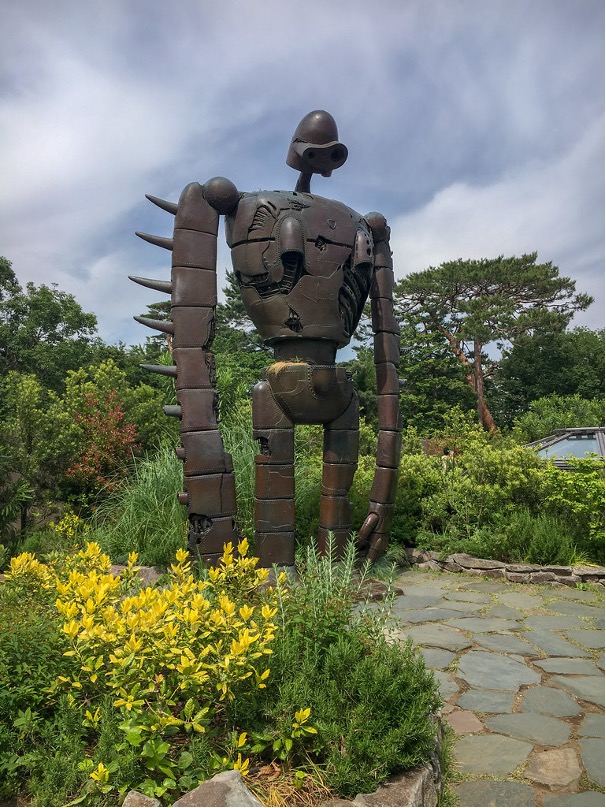Sheeta and Pazu’s 19th-century adventure, Laputa: Castle in the Sky, is celebrating its thirty-fifth anniversary in 2021. Could this steampunk fairy tale about two orphans also be seen as a movie dreaming up an ecotopia?
A shorthand term for ecological utopia. Ernest Callenbach who coined the term way back in his 1975 novel of the same name wrote, “What matters most is the aspiration to live in balance with nature, to walk lightly on the land, to treat the earth as a mother.”
High sounding words for our two protagonists who just want to get to the mysterious floating castle of Laputa, you might think. They of course have to fight the military on the ground and the pirates in the sky. In a bid to conquer the world, Colonel Mushka tries to capture Sheeta’s ancient stone so it can lead him to Laputa. The bad guy, emblematic of humankind’s greed and destruction.
In contrast, there are the sky pilots, inhabiting a greyer territory, led by the matriarch Dola. Donning pink braids, Dola is ready to fight anyone in quest of treasure. However, she is more soft-hearted than she lets on. Together, they all race to this mysterious kingdom, where nature and technology live together in peace. The perfect ecotopia.
The earth speaks to all of us, and if we listen, we can understand. These words set the signature theme of Studio Ghibli, known for its vibrant, ecological storytelling. Neither a foreground for human action nor just a passive scenery, Hayao Miyazaki’s landscape is an active character. As the plot unfolds, so does the landscape- constantly transforming and evolving with the characters. Every action of the human characters affects the larger environment, which affects humanity, all in a vicious loop. The message is clear. Man cannot extricate himself from nature, nor should he attempt to. As the lyrics of one of the songs in the movie unfold, “take root in the ground, live in harmony with the wind, plant your seeds in the winter and rejoice with the birds in the coming of spring.”
While East vs West storytelling often displays this battleground between living in harmony with nature in contrast to dominating it, what sets Laputa apart is its questioning of technology. Are these systems capable of coexisting with the spirit of ecotopia? Let’s look at the example of the Laputan robot soldiers.
These robots are large, sentient humanoids who can fly. When one of the formerly-thought dead robots is activated through Sheeta’s spell, it quickly devours the military facility. It is framed as yet another antagonist the duo must tackle. But soon enough, we see it meant no harm. It was only trying to escape. When another robot advances towards the duo, it is again not out of malice. It was to lift the glider off a bird’s nest so he could protect a nest of eggs.
These scenes show us that tech is tech, neither good nor bad. It is what humans make it do. The Laputan robot soldiers are, in equal parts, terrifying. They are capable of unleashing immense destruction. They are endearing, capable of nurturing woodland creatures on their shoulders. Benign gardener or destructive monster, their actions derive from the whims of their human master. Colonel Mushka’s machinations rest on the latter. A stark statement on how industrialisation and war are destructive to culture.
Yet, it also implies that in the right hands, machine intelligence may set an example of what an ethical relationship with nature might look like. By spelling out the amorality of AI, technology and everything in between, Miyazaki prods the audience to rethink our current technological systems. At best, our systems cater to human interests without factoring in the external symbiosis of living and non-living elements. At worst, they cater only to the interests of capitalists, ignoring other sections of society such as marginalised communities. Even the very creation of these technological systems is rooted in extraction that is exploitative to those from the lower strata of society. For instance, the mining community that Pazu belongs to works day and night to power the technology that keeps their island afloat, yet they receive none of the benefits. Their lives are characterized by uncertainty, suffering, and unremitting labour.
However, with a little bit of tinkering, humans can build into technologies the complexity of interrelationships that exist across living beings and environments. Coined by philosopher Arne Naess, deep ecology is the environmental philosophy that all living beings have inherent worth, regardless of their utility to humans. Hence, we as a species should strive for ecological harmony between all living entities and non-living systems. It is only through forging future technological systems that embrace all of Earth’s systems can we shift from human narcissism to values of deep ecology. This might just bring us closer to inhabiting an ecotopia.
Ecotopianism is ultimately a philosophy of hope, one rooted in a desire to change society for the better. And perhaps along the way, one can improve the human condition. Studio Ghibli’s Castle in the Sky embodies this yearning. It presents a window out of the current doom-laden state of humanity, and that alone makes it worth a watch.
Featured Image credit
Rishita Chaudhary is a second-year student studying political science, international relations, and media studies at Ashoka University.
We publish all articles under a Creative Commons Attribution-NoDerivatives license. This means any news organisation, blog, website, newspaper or newsletter can republish our pieces for free, provided they attribute the original source (OpenAxis).

